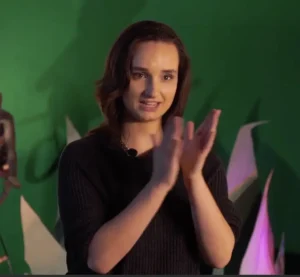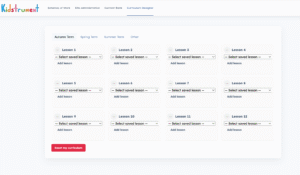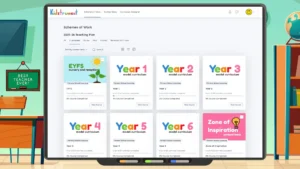Looking for easy, engaging music activities to grab your class’s attention? These five rhythm starters take just minutes to run, need no instruments, and fit perfectly into any primary lesson. Whether you’re a specialist or a classroom teacher looking for simple music resources, you’ll find something you can use today.
Each idea below links directly to a Kidstrument Activity you can open on your classroom screen. Every task supports the Model Music Curriculum and builds pupils’ confidence with pulse, rhythm, and performance.
1. Clap the Beat (EYFS–KS1)
Clap the Beat is a classic rhythm warm-up. Pupils pat, clap, and tap in time with a steady pulse while following colourful on-screen prompts. It’s a brilliant way to start lessons or refocus a restless class.
Teacher tip: Model strong posture and clear clapping — rhythm starts with body control!
2. Beat the Grid (KS1–KS2)
Turn rhythm into a visual puzzle with Beat the Grid. Each cell in the grid equals one beat — pupils fill them with movements, stamps, or percussion sounds. When you press play, they perform their own composition.
This activity introduces beat subdivision and early composition in a way that’s intuitive and fun.
3. Learn Rhythm: Supermarket
Combine literacy and music in Learn Rhythm: Supermarket. Children speak food names (“ap-ple”, “ba-na-na”) to discover natural rhythm patterns. It’s a simple link between speech and music, ideal for early years or quick recall tasks.
Extension: Invite pupils to invent their own “shopping list rhythm” and perform in groups.
4. Forbidden Rhythms (KS2 focus)
Forbidden Rhythms is part rhythm challenge, part memory game. Pupils echo every pattern you clap — except the forbidden one! It develops aural discrimination, listening focus, and self-control, and makes a perfect energiser mid-lesson.
5. Rhythmic Pyramid Pulse (Upper KS2)
Help pupils visualise note lengths with Rhythmic Pyramid Pulse. The pyramid diagram shows how minims, crotchets, and quavers relate. Students perform each layer to feel how note values stack — an easy bridge to notation.
How to Use These in Your Week
- Pick one starter per lesson — consistency builds timing.
- Rotate activities by skill focus: pulse → echo → composition.
- Use them as warm-ups, transitions, or brain breaks between subjects.
- Record short clips to show progression for assessment and Ofsted evidence.
More Primary Music Resources
Explore hundreds of interactive classroom activities covering rhythm, pitch, singing, and listening — all mapped to UK curriculum outcomes and designed for non-specialist teachers.
New to rhythm teaching? Read our companion guide Teaching Rhythm in Primary School: Strategies That Work.
Ready to get started? Visit Kidstrument.co.uk to build your free demo and see how easy music can be to teach.





